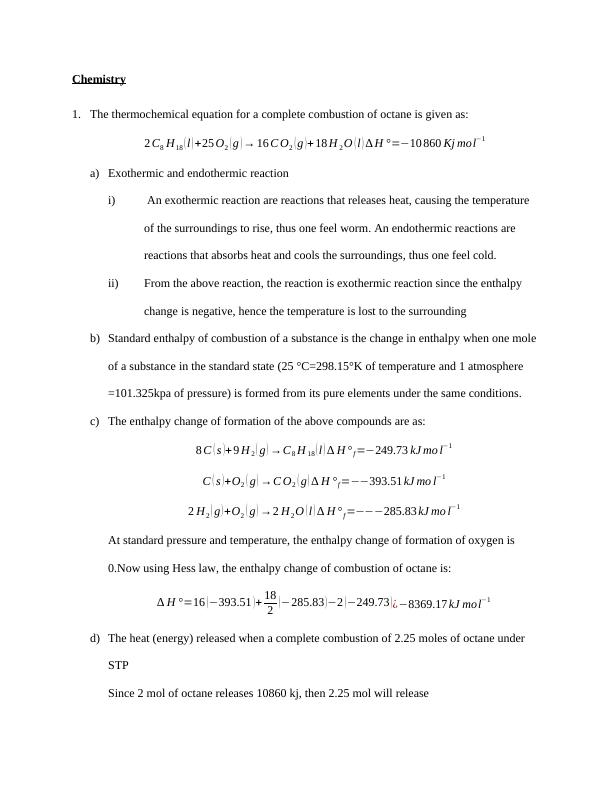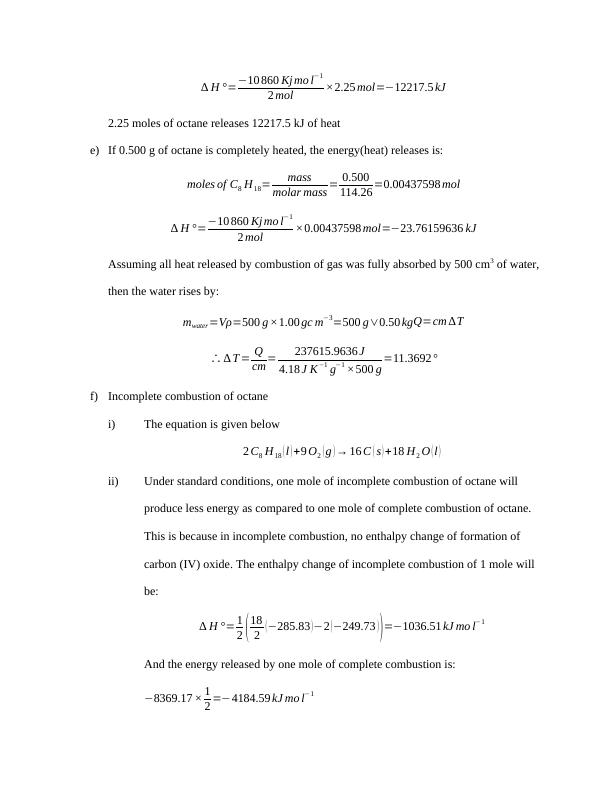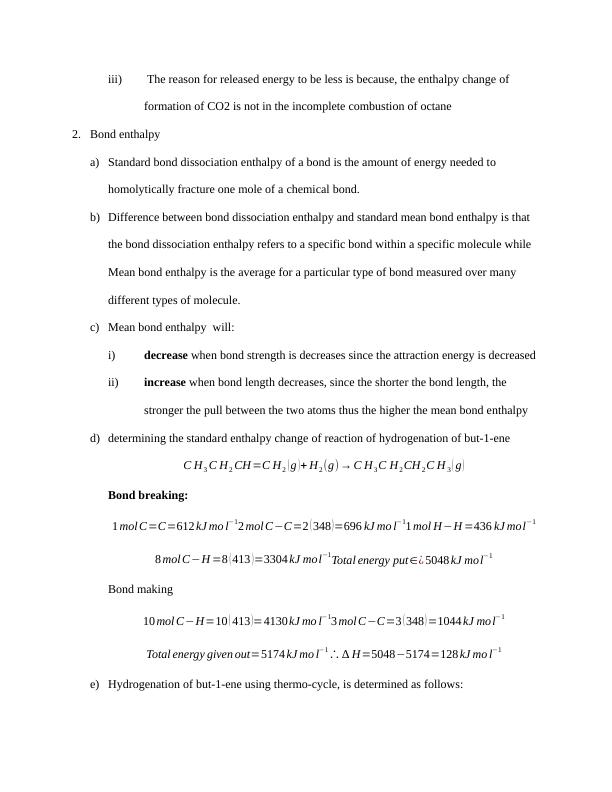Thermochemical Equation for Combustion of Octane and Bond Enthalpy
Added on 2023-04-23
6 Pages1517 Words352 Views
Chemistry
1. The thermochemical equation for a complete combustion of octane is given as:
2 C8 H18 ( l ) +25 O2 ( g ) → 16 C O2 ( g )+ 18 H 2 O ( l ) ∆ H °=−10 860 Kj mol−1
a) Exothermic and endothermic reaction
i) An exothermic reaction are reactions that releases heat, causing the temperature
of the surroundings to rise, thus one feel worm. An endothermic reactions are
reactions that absorbs heat and cools the surroundings, thus one feel cold.
ii) From the above reaction, the reaction is exothermic reaction since the enthalpy
change is negative, hence the temperature is lost to the surrounding
b) Standard enthalpy of combustion of a substance is the change in enthalpy when one mole
of a substance in the standard state (25 °C=298.15°K of temperature and 1 atmosphere
=101.325kpa of pressure) is formed from its pure elements under the same conditions.
c) The enthalpy change of formation of the above compounds are as:
8 C ( s )+ 9 H 2 ( g ) →C8 H 18 ( l ) ∆ H °f =−249.73 kJ mo l−1
C ( s ) +O2 ( g ) →C O2 ( g ) ∆ H °f =−−393.51 kJ mo l−1
2 H2 ( g ) +O2 ( g ) →2 H2 O ( l ) ∆ H ° f =−−−285.83 kJ mo l−1
At standard pressure and temperature, the enthalpy change of formation of oxygen is
0.Now using Hess law, the enthalpy change of combustion of octane is:
∆ H °=16 ( −393.51 ) + 18
2 ( −285.83 ) −2 ( −249.73 )¿−8369.17 kJ mol−1
d) The heat (energy) released when a complete combustion of 2.25 moles of octane under
STP
Since 2 mol of octane releases 10860 kj, then 2.25 mol will release
1. The thermochemical equation for a complete combustion of octane is given as:
2 C8 H18 ( l ) +25 O2 ( g ) → 16 C O2 ( g )+ 18 H 2 O ( l ) ∆ H °=−10 860 Kj mol−1
a) Exothermic and endothermic reaction
i) An exothermic reaction are reactions that releases heat, causing the temperature
of the surroundings to rise, thus one feel worm. An endothermic reactions are
reactions that absorbs heat and cools the surroundings, thus one feel cold.
ii) From the above reaction, the reaction is exothermic reaction since the enthalpy
change is negative, hence the temperature is lost to the surrounding
b) Standard enthalpy of combustion of a substance is the change in enthalpy when one mole
of a substance in the standard state (25 °C=298.15°K of temperature and 1 atmosphere
=101.325kpa of pressure) is formed from its pure elements under the same conditions.
c) The enthalpy change of formation of the above compounds are as:
8 C ( s )+ 9 H 2 ( g ) →C8 H 18 ( l ) ∆ H °f =−249.73 kJ mo l−1
C ( s ) +O2 ( g ) →C O2 ( g ) ∆ H °f =−−393.51 kJ mo l−1
2 H2 ( g ) +O2 ( g ) →2 H2 O ( l ) ∆ H ° f =−−−285.83 kJ mo l−1
At standard pressure and temperature, the enthalpy change of formation of oxygen is
0.Now using Hess law, the enthalpy change of combustion of octane is:
∆ H °=16 ( −393.51 ) + 18
2 ( −285.83 ) −2 ( −249.73 )¿−8369.17 kJ mol−1
d) The heat (energy) released when a complete combustion of 2.25 moles of octane under
STP
Since 2 mol of octane releases 10860 kj, then 2.25 mol will release

∆ H °=−10 860 Kj mo l−1
2 mol ×2.25 mol=−12217.5 kJ
2.25 moles of octane releases 12217.5 kJ of heat
e) If 0.500 g of octane is completely heated, the energy(heat) releases is:
moles of C8 H18= mass
molar mass = 0.500
114.26 =0.00437598 mol
∆ H °=−10 860 Kj mo l−1
2 mol ×0.00437598 mol=−23.76159636 kJ
Assuming all heat released by combustion of gas was fully absorbed by 500 cm3 of water,
then the water rises by:
mwater =Vρ=500 g ×1.00 gc m−3=500 g∨0.50 kgQ=cm ∆T
∴ ∆ T = Q
cm= 237615.9636 J
4.18 J K−1 g−1 ×500 g =11.3692°
f) Incomplete combustion of octane
i) The equation is given below
2 C8 H18 ( l ) +9 O2 ( g ) → 16 C ( s ) +18 H2 O ( l )
ii) Under standard conditions, one mole of incomplete combustion of octane will
produce less energy as compared to one mole of complete combustion of octane.
This is because in incomplete combustion, no enthalpy change of formation of
carbon (IV) oxide. The enthalpy change of incomplete combustion of 1 mole will
be:
∆ H °= 1
2 ( 18
2 ( −285.83 ) −2 ( −249.73 ) ) =−1036.51 kJ mo l−1
And the energy released by one mole of complete combustion is:
−8369.17 × 1
2 =−4184.59 kJ mo l−1
2 mol ×2.25 mol=−12217.5 kJ
2.25 moles of octane releases 12217.5 kJ of heat
e) If 0.500 g of octane is completely heated, the energy(heat) releases is:
moles of C8 H18= mass
molar mass = 0.500
114.26 =0.00437598 mol
∆ H °=−10 860 Kj mo l−1
2 mol ×0.00437598 mol=−23.76159636 kJ
Assuming all heat released by combustion of gas was fully absorbed by 500 cm3 of water,
then the water rises by:
mwater =Vρ=500 g ×1.00 gc m−3=500 g∨0.50 kgQ=cm ∆T
∴ ∆ T = Q
cm= 237615.9636 J
4.18 J K−1 g−1 ×500 g =11.3692°
f) Incomplete combustion of octane
i) The equation is given below
2 C8 H18 ( l ) +9 O2 ( g ) → 16 C ( s ) +18 H2 O ( l )
ii) Under standard conditions, one mole of incomplete combustion of octane will
produce less energy as compared to one mole of complete combustion of octane.
This is because in incomplete combustion, no enthalpy change of formation of
carbon (IV) oxide. The enthalpy change of incomplete combustion of 1 mole will
be:
∆ H °= 1
2 ( 18
2 ( −285.83 ) −2 ( −249.73 ) ) =−1036.51 kJ mo l−1
And the energy released by one mole of complete combustion is:
−8369.17 × 1
2 =−4184.59 kJ mo l−1

iii) The reason for released energy to be less is because, the enthalpy change of
formation of CO2 is not in the incomplete combustion of octane
2. Bond enthalpy
a) Standard bond dissociation enthalpy of a bond is the amount of energy needed to
homolytically fracture one mole of a chemical bond.
b) Difference between bond dissociation enthalpy and standard mean bond enthalpy is that
the bond dissociation enthalpy refers to a specific bond within a specific molecule while
Mean bond enthalpy is the average for a particular type of bond measured over many
different types of molecule.
c) Mean bond enthalpy will:
i) decrease when bond strength is decreases since the attraction energy is decreased
ii) increase when bond length decreases, since the shorter the bond length, the
stronger the pull between the two atoms thus the higher the mean bond enthalpy
d) determining the standard enthalpy change of reaction of hydrogenation of but-1-ene
C H3 C H2 CH =C H2 ( g )+ H2 (g)→ C H3 C H2 CH 2 C H 3 ( g )
Bond breaking:
1 mol C=C=612 kJ mo l−1 2 mol C−C=2 ( 348 ) =696 kJ mo l−11 mol H−H =436 kJ mol−1
8 mol C−H =8 ( 413 )=3304 kJ mol−1 Total energy put∈¿ 5048 kJ mol−1
Bond making
10 mol C−H=10 ( 413 ) =4130 kJ mo l−1 3 mol C−C=3 ( 348 ) =1044 kJ mol−1
Total energy given out=5174 kJ mo l−1∴ ∆ H=5048−5174=128 kJ mo l−1
e) Hydrogenation of but-1-ene using thermo-cycle, is determined as follows:
formation of CO2 is not in the incomplete combustion of octane
2. Bond enthalpy
a) Standard bond dissociation enthalpy of a bond is the amount of energy needed to
homolytically fracture one mole of a chemical bond.
b) Difference between bond dissociation enthalpy and standard mean bond enthalpy is that
the bond dissociation enthalpy refers to a specific bond within a specific molecule while
Mean bond enthalpy is the average for a particular type of bond measured over many
different types of molecule.
c) Mean bond enthalpy will:
i) decrease when bond strength is decreases since the attraction energy is decreased
ii) increase when bond length decreases, since the shorter the bond length, the
stronger the pull between the two atoms thus the higher the mean bond enthalpy
d) determining the standard enthalpy change of reaction of hydrogenation of but-1-ene
C H3 C H2 CH =C H2 ( g )+ H2 (g)→ C H3 C H2 CH 2 C H 3 ( g )
Bond breaking:
1 mol C=C=612 kJ mo l−1 2 mol C−C=2 ( 348 ) =696 kJ mo l−11 mol H−H =436 kJ mol−1
8 mol C−H =8 ( 413 )=3304 kJ mol−1 Total energy put∈¿ 5048 kJ mol−1
Bond making
10 mol C−H=10 ( 413 ) =4130 kJ mo l−1 3 mol C−C=3 ( 348 ) =1044 kJ mol−1
Total energy given out=5174 kJ mo l−1∴ ∆ H=5048−5174=128 kJ mo l−1
e) Hydrogenation of but-1-ene using thermo-cycle, is determined as follows:

End of preview
Want to access all the pages? Upload your documents or become a member.
Related Documents
Chemical Reactions and Equilibrium Constantslg...
|6
|1578
|282
Food as Energy – Fuel for Life: Chemistry Essentials Scenario-Based Problemlg...
|10
|3067
|450
Principles of Chemical Reactionslg...
|4
|591
|465
